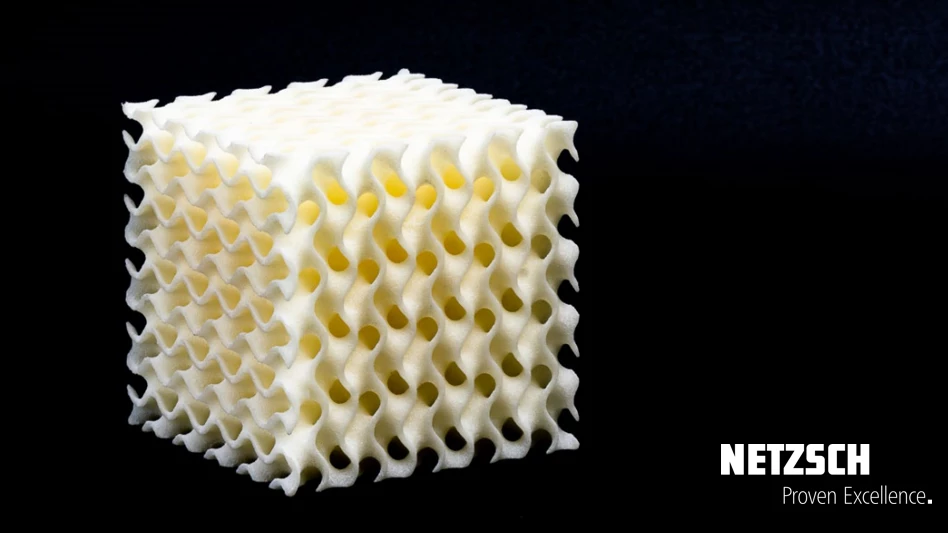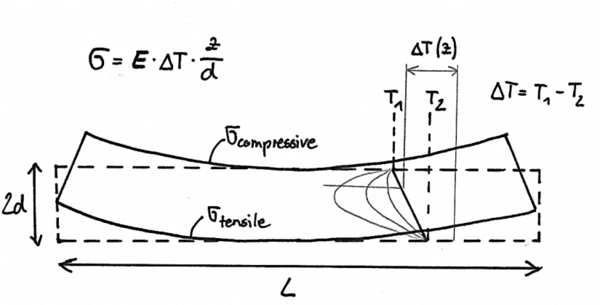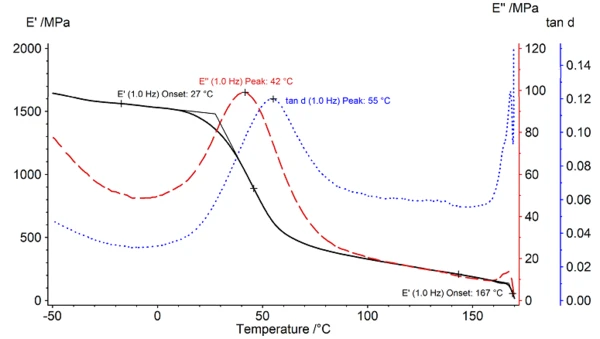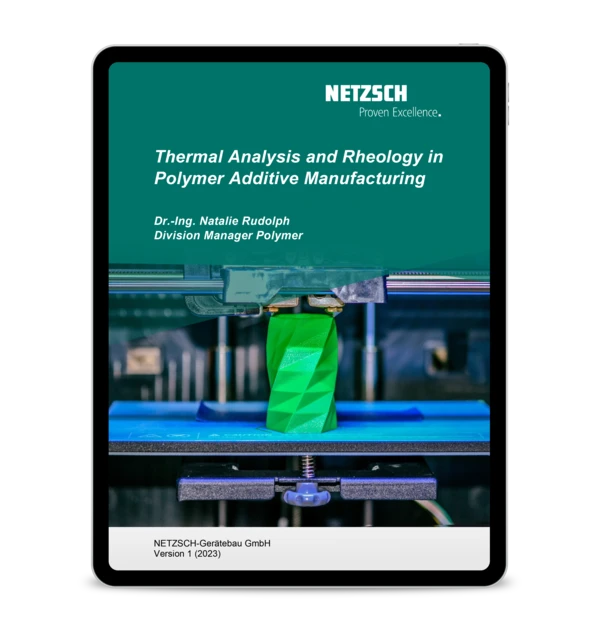
08.03.2021 by Dr. Natalie Rudolph, Rüdiger Sehling
Estimating Residual Stresses in SLS Parts Using DMA
Selective Laser SinteringSintering is a production process for forming a mechanically strong body out of a ceramic or metallic powder. Sintering (SLS) is one of the most used Additive Manufacturing technologies to produce structural plastic parts. When operated at elevated temperature, any residual stresses could be detrimental for the part performance. In order to better understand residual stresses, knowledge of a material’s modulus is needed. Learn more about residual StressStress is defined as a level of force applied on a sample with a well-defined cross section. (Stress = force/area). Samples having a circular or rectangular cross section can be compressed or stretched. Elastic materials like rubber can be stretched up to 5 to 10 times their original length.stress and how to measure the material property using a thermal analysis method.
Therefore, their dimensional accuracy has to be high to fit well in bigger assemblies during their service lives. When operated at elevated temperature, any residual stresses could be detrimental for the part performance. In order to better understand residual stresses, knowledge of a material’s modulus is needed.
The modulus of materials including polymers is typically measured in static mechanical tests, where the StressStress is defined as a level of force applied on a sample with a well-defined cross section. (Stress = force/area). Samples having a circular or rectangular cross section can be compressed or stretched. Elastic materials like rubber can be stretched up to 5 to 10 times their original length.stress-StrainStrain describes a deformation of a material, which is loaded mechanically by an external force or stress. Rubber compounds show creep properties, if a static load is applied.strain behavior during a tensile test is plotted and the Young’s modulus is calculated as the slope of the curve between 0.05…0.25% StrainStrain describes a deformation of a material, which is loaded mechanically by an external force or stress. Rubber compounds show creep properties, if a static load is applied.strain. It can be used for quality assurance, material development and optimization as well as some dimensioning tasks. However, it cannot be used for component design and simulation.
For this, it is important to obtain time- and temperature-dependent data that predicts the material behavior over the service life at realistic loading conditions. The method of choice is Dynamic-Mechanical Analysis (DMA), which allows for the sample to be subjected to a sinusoidal load and the viscoelastic response of the material is detected. By varying the temperature and frequency of the measurement, the temperature and time dependence can be analyzed as well.
For understanding the SLS part property development during printing and in particular shrinkage and warpage, a temperature-dependent DMA measurement is required. During the constant cycle of powder coating and laser melting, the temperature is constantly changing within the part and a temperature gradient is forming from the bottom of the part to the top. This can cause warpage, which is explained in this previous post on thermal expansion.
Understanding residual stresses within the SLS part
However, another effect of warpage is the build up of residual stresses, σ, within the part, which are affected by the E modulus and the temperature gradient. The following simplified relationship exists:

where ΔT is the temperature gradient between top and bottom, d is the thickness of the part and z denotes a certain location across the thickness of the part. From this relationship, it can be seen that for a given geometry, the larger the temperature gradient and/or the higher the modulus, the higher are the residual stresses.

How to determine residual stresses using DMA
To obtain the temperature dependent modulus data, dogbone specimens were printed at the Institute of Polymer Technology (LKT) of the University Erlangen-Nuremberg with PA12 powder using standard parameters of 0.4 J/mm3. Then, samples were prepared at NETZSCH Analyzing & Testing by cutting the middle pieces of these dogbones to 50 mm length, which results in beams of 50 mm x 10 mm x 4.5 mm dimensions. Even so the surface shows the typical roughness of SLS parts, no additional surface treatment was selected, because the surfaces were plane-parallel.
The samples were then loaded in the 40-mm wide flexural fixture of the NETZSCH DMA 242 E Artemis. Following an initial cooling and equilibration step, the samples were heated from -50°C to 180°C at 2 K/min, which is just below the Melting Temperatures and EnthalpiesThe enthalpy of fusion of a substance, also known as latent heat, is a measure of the energy input, typically heat, which is necessary to convert a substance from solid to liquid state. The melting point of a substance is the temperature at which it changes state from solid (crystalline) to liquid (isotropic melt).melting temperature of the material. All measurement conditions are summarized in the following table:
Table 1: Measurement conditions
| Sample holder | 3 point bending, 40 mm span length |
| Proportional force factor | 1.2 |
| Dynamic load | max. 10 N |
| Amplitude | 30 µm |
| Frequency | 1 Hz |
| Temperature range | -50…180°C at a heating rate of 2 K/min |
The elastic response is most important
Figure 2 depicts the measurement results of storage modulus E’, Viscous modulusThe complex modulus (viscous component), loss modulus, or G’’, is the “imaginary” part of the samples the overall complex modulus. This viscous component indicates the liquid like, or out of phase, response of the sample being measurement. loss modulus E” as well as the damping factor tand. They show the typical behavior of a semi-crystalline thermoplastic material. The storage modulus exhibits a drop at the transition temperatures, Glass Transition TemperatureThe glass transition is one of the most important properties of amorphous and semi-crystalline materials, e.g., inorganic glasses, amorphous metals, polymers, pharmaceuticals and food ingredients, etc., and describes the temperature region where the mechanical properties of the materials change from hard and brittle to more soft, deformable or rubbery.glass transition and melting, and the Viscous modulusThe complex modulus (viscous component), loss modulus, or G’’, is the “imaginary” part of the samples the overall complex modulus. This viscous component indicates the liquid like, or out of phase, response of the sample being measurement. loss modulus and tand shows a maximum. The factor used for the analysis is chosen based on the effect that is of most interest. To understand shrinkage and residual StressStress is defined as a level of force applied on a sample with a well-defined cross section. (Stress = force/area). Samples having a circular or rectangular cross section can be compressed or stretched. Elastic materials like rubber can be stretched up to 5 to 10 times their original length.stress build up, the elastic response (E’) is the most important and will be analyzed here.
With increasing temperature, the storage modulus continuously decreases. The value of E’ at room temperature is 1438 MPa. The data sheet of the measured sample typically shows different values (here: 1650 MPa) because the Young’s modulus is measured in tension. During a DMA measurement in flexural mode, both the compressive and tensile load act on the sample, especially when measuring thicker samples. The onset of the Glass Transition TemperatureThe glass transition is one of the most important properties of amorphous and semi-crystalline materials, e.g., inorganic glasses, amorphous metals, polymers, pharmaceuticals and food ingredients, etc., and describes the temperature region where the mechanical properties of the materials change from hard and brittle to more soft, deformable or rubbery.glass transition was determined to be 27°C. After the drop in modulus, the values further decrease from 500 MPa to 114 MPa at the onset of melting (167°C).

While the value of the storage modulus E’ just below melting is very important for a successful printing process, the whole progression is important during the cooling stage. Due to the big change in modulus at the Glass Transition TemperatureThe glass transition is one of the most important properties of amorphous and semi-crystalline materials, e.g., inorganic glasses, amorphous metals, polymers, pharmaceuticals and food ingredients, etc., and describes the temperature region where the mechanical properties of the materials change from hard and brittle to more soft, deformable or rubbery.glass transition, the cooling process has to be very slow (> 12 h for the whole build) to reduce or eliminate warpage and residual StressStress is defined as a level of force applied on a sample with a well-defined cross section. (Stress = force/area). Samples having a circular or rectangular cross section can be compressed or stretched. Elastic materials like rubber can be stretched up to 5 to 10 times their original length.stress build-up during this stage. Understanding this behavior can help optimize the process and potentially accelerate this time-consuming process step.
About the Institute of Polymer Technology (LKT)
The Institute of Polymer Technology is an academic research institute at the Friedrich-Alexander University of Erlangen-Nuremberg. It is one of the leaders in Additive Manufacturing research; particularly SLS. Other main research areas include Lightweight Design and FRP, Materials and Processing, Joining Technology and Tribology. In addition to these research focuses, the institute is also working on cross-disciplinary topics such as Filler Material Compounding, Simulation of Processing and Applications, Radiation Cross-linked Thermoplastics, Gentle Processing and many more.

FREE E-Book
Thermal Analysis and Rheology in Polymer Additive Manufacturing
Discover the secrets behind AM's game-changing capabilities! Our newly released ebook delves deep into the heart of AM, unveiling the power of reliable material characterization techniques, specifically thermal analysis and rheology.